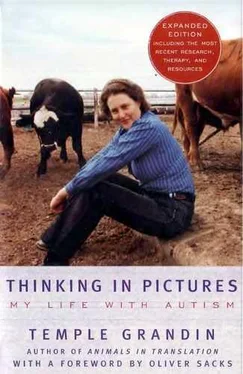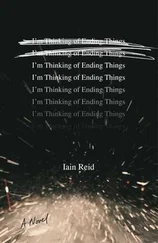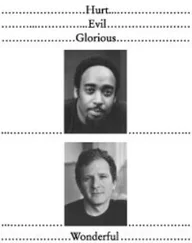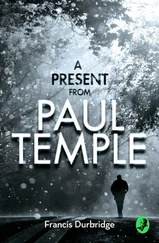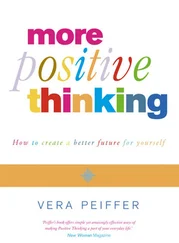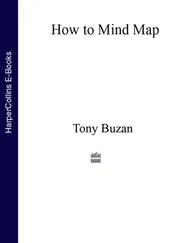When I am unable to convert text to pictures, it is usually because the text has no concrete meaning. Some philosophy books and articles about the cattle futures market are simply incomprehensible. It is much easier for me to understand written text that describes something that can be easily translated into pictures. The following sentence from a story in the February 21, 1994, issue of Time magazine, describing the Winter Olympics figure-skating championships, is a good example: «All the elements are in place — the spotlights, the swelling waltzes and jazz tunes, the sequined sprites taking to the air.» In my imagination I see the skating rink and skaters. However, if I ponder too long on the word «elements,» I will make the inappropriate association of a periodic table on the wall of my high school chemistry classroom. Pausing on the word «sprite» triggers an image of a Sprite can in my refrigerator instead of a pretty young skater.
Teachers who work with autistic children need to understand associative thought patterns. An autistic child will often use a word in an inappropriate manner. Sometimes these uses have a logical associative meaning and other times they don't. For example, an autistic child might say the word «dog» when he wants to go outside. The word «dog» is associated with going outside. In my own case, I can remember both logical and illogical use of inappropriate words. When I was six, I learned to say «prosecution.» I had absolutely no idea what it meant, but it sounded nice when I said it, so I used it as an exclamation every time my kite hit the ground. I must have baffled more than a few people who heard me exclaim «Prosecution!» to my downward-spiraling kite.
Discussions with other autistic people reveal similar visual styles of thinking about tasks that most people do sequentially. An autistic man who composes music told me that he makes «sound pictures» using small pieces of other music to create new compositions. A computer programmer with autism told me that he sees the general pattern of the program tree. After he visualizes the skeleton for the program, he simply writes the code for each branch. I use similar methods when I review scientific literature and troubleshoot at meat plants. I take specific findings or observations and combine them to find new basic principles and general concepts.
My thinking pattern always starts with specifics and works toward generalization in an associational and nonsequential way. As if I were attempting to figure out what the picture on a jigsaw puzzle is when only one third of the puzzle is completed, I am able to fill in the missing pieces by scanning my video library. Chinese mathematicians who can make large calculations in their heads work the same way. At first they need an abacus, the Chinese calculator, which consists of rows of beads on wires in a frame. They make calculations by moving the rows of beads. When a mathematician becomes really skilled, he simply visualizes the abacus in his imagination and no longer needs a real one. The beads move on a visualized video abacus in his brain.
Growing up, I learned to convert abstract ideas into pictures as a way to understand them. I visualized concepts such as peace or honesty with symbolic images. I thought of peace as a dove, an Indian peace pipe, or TV or newsreel footage of the signing of a peace agreement. Honesty was represented by an image of placing one's hand on the Bible in court. A news report describing a person returning a wallet with all the money in it provided a picture of honest behavior.
The Lord's Prayer was incomprehensible until I broke it down into specific visual images. The power and the glory were represented by a semicircular rainbow and an electrical tower. These childhood visual images are still triggered every time I hear the Lord's Prayer. The words «thy will be done» had no meaning when I was a child, and today the meaning is still vague. Will is a hard concept to visualize. When I think about it, I imagine God throwing a lightning bolt. Another adult with autism wrote that he visualized «Thou art in heaven» as God with an easel above the clouds. «Trespassing» was pictured as black and orange no trespassing signs. The word «Amen» at the end of the prayer was a mystery: a man at the end made no sense.
As a teenager and young adult I had to use concrete symbols to understand abstract concepts such as getting along with people and moving on to the next steps of my life, both of which were always difficult. I knew I did not fit in with my high school peers, and I was unable to figure out what I was doing wrong. No matter how hard I tried, they made fun of me. They called me «workhorse,» «tape recorder,» and «bones» because I was skinny. At the time I was able to figure out why they called me «workhorse» and «bones,» but «tape recorder» puzzled me. Now I realize that I must have sounded like a tape recorder when I repeated things verbatim over and over. But back then I just could not figure out why I was such a social dud. I sought refuge in doing things I was good at, such as working on reroofing the barn or practicing my riding prior to a horse show. Personal relationships made absolutely no sense to me until I developed visual symbols of doors and windows. It was then that I started to understand concepts such as learning the give-and-take of a relationship. I still wonder what would have happened to me if I had not been able to visualize my way in the world.
The really big challenge for me was making the transition from high school to college. People with autism have tremendous difficulty with change. In order to deal with a major change such as leaving high school, I needed a way to rehearse it, acting out each phase in my life by walking through an actual door, window, or gate. When I was graduating from high school, I would go and sit on the roof of my dormitory and look up at the stars and think about how I would cope with leaving. It was there I discovered a little door that led to a bigger roof while my dormitory was being remodeled. While I was still living in this old New England house, a much larger building was being constructed over it. One day the carpenters tore out a section of the old roof next to my room. When I walked out, I was now able to look up into the partially finished new building. High on one side was a small wooden door that led to the new roof. The building was changing, and it was now time for me to change too. I could relate to that. I had found the symbolic key.
When I was in college, I found another door to symbolize getting ready for graduation. It was a small metal trap door that went out onto the flat roof of the dormitory. I had to actually practice going through this door many times. When I finally graduated from Franklin Pierce, I walked through a third, very important door, on the library roof.
I no longer use actual physical doors or gates to symbolize each transition in my life. When I reread years of diary entries while writing this book, a clear pattern emerged. Each door or gate enabled me to move on to the next level. My life was a series of incremental steps. I am often asked what the single breakthrough was that enabled me to adapt to autism. There was no single breakthrough. It was a series of incremental improvements. My diary entries show very clearly that I was fully aware that when I mastered one door, it was only one step in a whole series.
April 22, 1970
Today everything is completed at Franklin Pierce College and it is now time to walk through the little door in the library. I ponder now about what I should leave as a message on the library roof for future people to find.
I have reached the top of one step and I am now at the bottom step of graduate school.
For the top of the building is the highest point on campus and I have gone as far as I can go now.
Читать дальше
